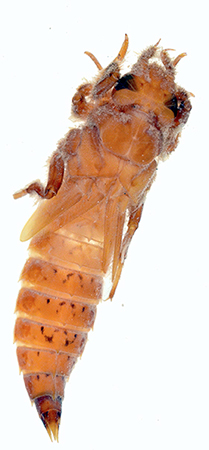 Aquatic Insects of Michigan
Aquatic Insects of Michigan
by Ethan Bright, Museum of Zoology Insect Division and School of Natural Resources and Environment
University of Michigan
- Home
- Species Lists
- Coleoptera
- Diptera
- Ephemeroptera
- Acanthametropodidae
- Ameletidae
- Ametropodidae
- Arthropleidae
- Baetidae
- Baetiscidae
- Behningiidae
- Caenidae
- Ephemerellidae
- Ephemeridae
- Heptageniidae
- Isonychiidae
- Leptohyphidae
- Leptophlebiidae
- Metretopodidae
- Neoephemeridae
- Oligoneuriidae
- Palingeniidae
- Polymitarcyidae
- Potamanthidae
- Pseudironidae
- Siphlonuridae
- Heteroptera
- Hymenoptera
- Lepidoptera
- Megaloptera
- Neuroptera (Sisyridae)
- Odonata
- Orthoptera
- Plecoptera
- Trichoptera
- Other Orders
- Keys/Identification
- Aquatic Insects of Michigan
Progomphus (Gomphidae) (Sanddragons) of Michigan - Identification
A genus of primarily neotropical gomphid dragonflies, one species - Progomphus obscurus (Rambur, 1842) - is widely distributed in temperate North America and is found across the LP of Michigan in streams and lakes of the LP wherever sandy woodland habitat exists. Based on its distribution in Wisconsin, it is also likely to be found in the UP.
Adults are medium-sized handsom dragonflies, richly patterned in brown and yellow with blue-gray eyes, yellowish face, brown and yellow stripes on the thorax, and a blackish abdomen patterned in yellowish, rear-pointing triangles, the last 4 segments mostly to entirely dark. Nymphs are distinctive among our gomphids for their long, slender angulate fourth antennal segment as well as the closely appressed position of the middle coxa. These features facilitate burrowing into shifting sand substrates of streams and lakes (Needham and Westfall 1955). Huggins and DuBois (1982) studied habitat and dietary preference of P. obscurus larvae in a stream in Kansas. He found that nymphs were significantly correlated to sand and gravel substrates, and did not appear to conflict with another gomphid burrower, Gomphus externus, which largely shared the same prey choice. They describe the method of burrowing, which occured in a random pattern throughout the study site: "Larvae of P. obscurus spread their hind legs downward and outward from their body. This allowed their hind legs to act as braces in the sand and prevented the dragonfly from being swept downstream. They initiated burrowing activity immediately after becoming stable and were able to burrow from sight in two to five seconds. Burrowing was accomplished using the front and middle legs only. This species was never observed to burrow deeper than 2 cm. Most individuals were found from 8-17 mm below the surface... Generally, smaller larvae burrowed less deeply than larger ones." Their diet was predominately made up of collector-gatherer chironomids.
[Photo of Progomphus obscurus nymph taken by Mark O'Brien, UMMZ-Insect Division, 2016)
(Taxonomic References: Needham et al. 2014, Paulson 2011)
References
Needham JG, Westfall MJ, May ML. 2014. Dragonflies of North America, Third Edition. Scientific Publishers, Gainesville, Florida, USA. xiv + 657 p.
Paulson D. 2011. Dragonflies and damselflies of the East. Princeton Field Guides. Princeton University Press, Pinceton, New Jersey, USA. 538 p.
Walker EM. 1958. The Odonata of Canada and Alaska, Volume 2. University of Toronto Press: Toronto, Ontario, Canada. xii + 318.
Page created: July 17, 1998 - Last updated: February 24, 2017